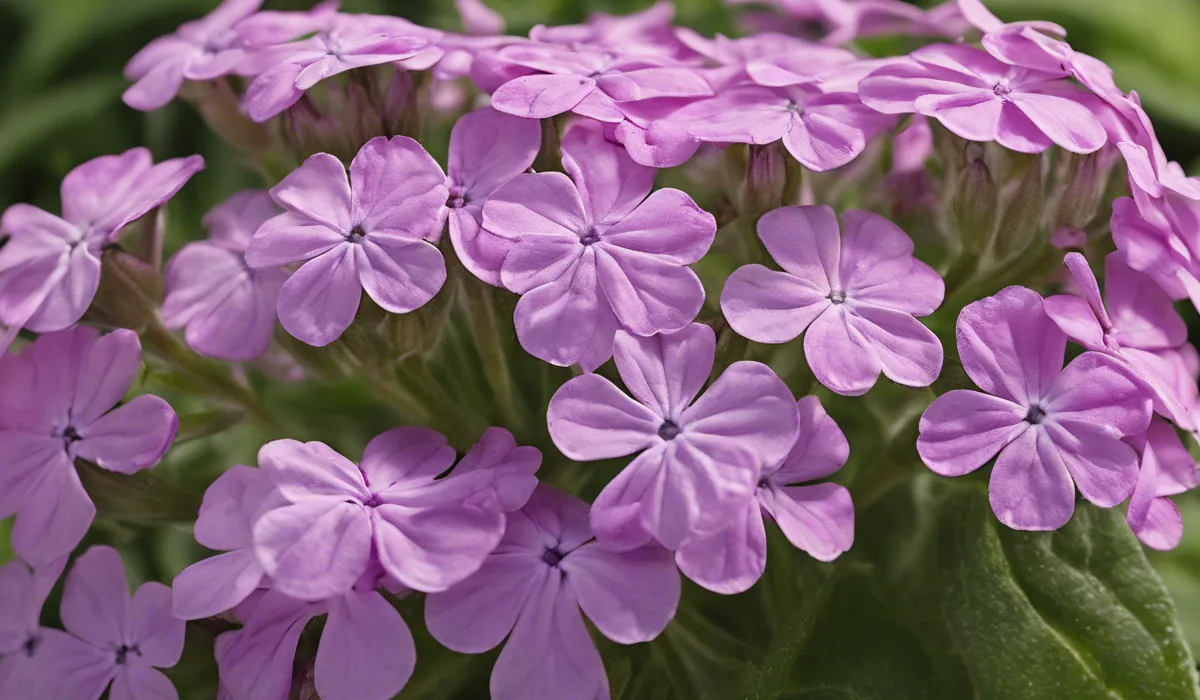To treat mildew on phlox, remove affected leaves, improve air circulation, and apply a fungicide like neem oil or potassium bicarbonate. Ensure proper plant spacing and avoid overhead watering to prevent recurrence.
Identification of Mildew on Phlox

Visual Signs of Mildew on Phlox Plants
Mildew on phlox plants is relatively easy to spot. You may notice a powdery white or gray substance on the leaves and stems of your plants.
This substance can start as small, localized patches that gradually spread, covering a large area.
The leaves might also begin to turn yellow or brown and become dry or brittle. If you see these symptoms, it’s likely that your phlox is suffering from mildew.
Difference Between Mildew and Other Common Plant Diseases
It’s important to differentiate between mildew and other plant diseases like black spot or rust.
Mildew is a surface fungus that does not penetrate the tissues of the plant, while other diseases can cause more severe internal damage.
Mildew typically looks like a powdery coating, whereas black spot and rust will manifest as distinct spots or pustules on the plant’s surface.
Impact of Mildew on the Health of Phlox Plants
Mildew can severely impact the health and vigor of phlox plants. It can stunt growth, reduce flowering, and in severe cases, lead to the death of the plant.
Mildew weakens the plant by interfering with photosynthesis, reducing the plant’s ability to produce the energy it needs to thrive.
Prevention of Mildew in Phlox

Best Practices for Planting and Spacing to Promote Air Circulation
Proper planting and spacing are crucial for preventing mildew. Ensure that phlox plants have enough space between them for air to circulate freely.
This helps to keep the foliage dry and reduces the humidity that mildew spores need to thrive. A good rule of thumb is to plant phlox at least one to two feet apart.
The Role of Sunlight and Proper Shading
Sunlight is a powerful ally in the fight against mildew. Phlox plants thrive in areas that receive at least six hours of sunlight per day.
This exposure helps to keep the plants dry and less hospitable to mildew growth. However, in extremely hot climates, some afternoon shade may be beneficial to prevent scorching.
Watering Techniques to Reduce Mildew Risk
Watering techniques can significantly influence mildew development. It’s best to water phlox plants at the base to avoid wetting the foliage.
Overhead watering can create a damp environment that mildew spores love. Watering in the morning allows any moisture on the leaves to dry before the cooler evening temperatures set in.
Choosing Resistant Phlox Varieties
Selecting phlox varieties that are resistant to mildew can save a lot of trouble. Many modern cultivars have been bred for disease resistance.
Speak with your local nursery or extension office to find out which varieties are best suited for your area and less prone to mildew.
Treatment of Mildew on Phlox

Natural Remedies for Treating Mildew
If you prefer a natural approach, there are several remedies you can use. Neem oil is a natural fungicide that can help control mildew.
Apply it according to the label instructions, usually in the early morning or late afternoon to avoid leaf burn.
Another option is a homemade baking soda spray, consisting of a teaspoon of baking soda mixed with a quart of water.
Chemical Fungicides Appropriate for Phlox Mildew
For more severe infestations, chemical fungicides may be necessary. Products containing potassium bicarbonate are effective against mildew.
Be sure to follow the application instructions on the label carefully, as incorrect use can harm the plant and the environment.
Steps for Applying Treatments to Infected Plants
When applying treatments, start by removing affected leaves to prevent the spread of spores.
Then, apply your chosen treatment to the entire plant, ensuring that you cover all surfaces.
It’s best to treat your plants on a calm, dry day to prevent the treatment from washing away or spreading to other plants.
Monitoring and Ongoing Care Following Treatment
After treating mildew, monitor your plants regularly for signs of recurrence. Continue to apply preventive measures, such as proper spacing and watering techniques.
It may also be helpful to apply a preventative fungicide spray every few weeks during the growing season, especially during warm, humid periods.
FAQs About Treating Mildew on Phlox
What should I do first when I notice mildew on my phlox?
When you notice mildew on your phlox, immediately remove any affected leaves to prevent the spread of the disease.
How can I improve air circulation for my phlox plants?
Improve air circulation by ensuring proper spacing between plants and pruning any dense foliage that may be restricting airflow.
What type of fungicide is recommended for treating mildew on phlox?
For treating mildew on phlox, apply a fungicide such as neem oil or potassium bicarbonate according to the product’s instructions.
How can I prevent mildew from recurring on my phlox?
Prevent mildew recurrence on phlox by avoiding overhead watering, ensuring proper plant spacing, and applying preventive fungicides if necessary.
Is it safe to use neem oil on phlox for treating mildew?
Yes, neem oil is safe to use on phlox and can be an effective fungicidal treatment for mildew when used as directed.
Final Thoughts
To combat mildew on phlox, it’s essential to remove any affected foliage promptly and improve air flow around the plants.
Application of fungicides such as neem oil or potassium bicarbonate can effectively address the issue.
Preventative measures include adequate plant spacing and avoiding overhead watering to reduce the risk of future outbreaks.
